Sotheby's Masters Week Sales in New York: Discover the Highlights
(by art historian Giulia Santoro)
Sotheby’s annual Masters Week auctions will be held in New York, 25 January to 2 February 2019, presenting a wide selection of outstanding artworks ranging from the 14th to 19th century. Paintings, sculptures and drawings by iconic artists such as Pieter Bruegel the Younger and Rubens will be on view in Sotheby’s Headquarters from Friday 25 January.
This year the Master Painting evening sale and the Master Paintings & Sculpture Day Sale will bring together rare works from women artists spanning four centuries of European Art. The Swiss Neoclassical painter Angelika Kauffmann, the French portraitist Élisabeth Louise Vigée-Le Brun and the Italian baroque painter Artemisia Gentileschi are almost certainly the most remarkable artists of the “Female Triumphant Sale”.
The Old Master drawings sale will feature impressive works covering many different drawings techniques, from ink to gouache, but the main focus of the sale is a drawing by the master of the Flemish baroque Peter Paul Rubens, from the collection of King William II of The Netherlands and his Russian wife Anna Pavlovna.
Selected Lots from the Master Paintings Evening Sale, 30 January 2019, New York: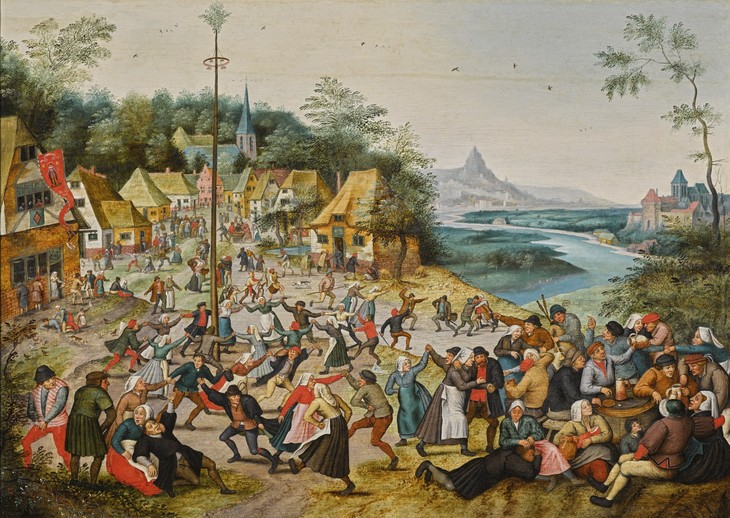
Pieter Brueghel the Younger, St. George’s Kermis with the dance around the maypole
signed and dated lower left: P BREVGHEL.1627
oil on panel, 54.6 by 75.7 cm.
Pieter Brueghel the Younger is particularly famous for his detailed scenes of peasant life and “world landscapes”. This painting depicts a beautiful scene of a Flemish village during a typical Netherlandish kermis. Originally a feast day for a patron saint, the kermis became a combination carnival, festival, fair, and religious observance, and was one of Brueghel’s favourite subjects.
This kermis celebrates the feast day of Saint George which took place on April 23rd. The saint is represented on a banner to the left and is recognizable by his attributes of the bow and arrow.
On a similar banner that appears in the Fair of Saint George’s day, an etching by Joannes and Lucas van Doetecum after Pieter Bruegel the Elder, inscribed on the ribbon over the saint is the phrase laet die boeren haer kermis houuen, or “let the peasants have their kermis”. This slogan was a protest against an edict of Holy Roman Emperor Charles V limiting the kermis to a single day because of the notorious drunken excesses associated with the fair. See Price Estimate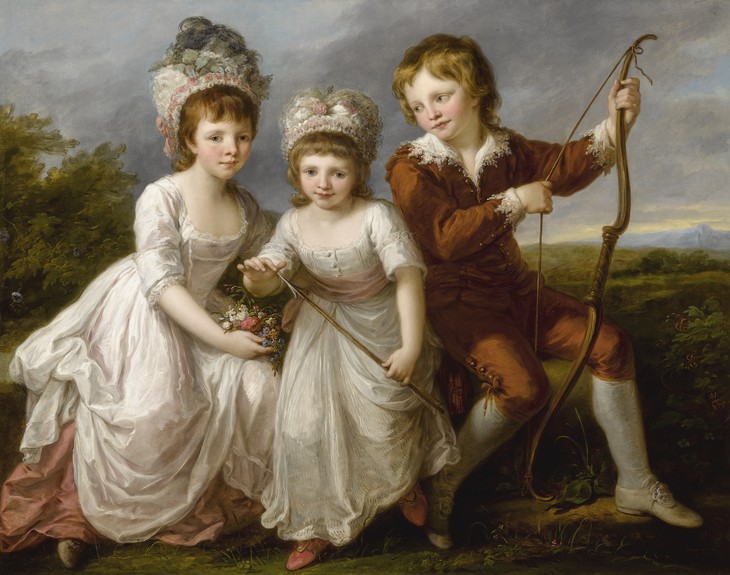 Angelika Kauffmann, R.A., Portrait of three children, almost certainly Lady Georgiana Spenser, later Duchess of Devonshire, Lady Henrietta Spencer and George Viscount Althorp
Angelika Kauffmann, R.A., Portrait of three children, almost certainly Lady Georgiana Spenser, later Duchess of Devonshire, Lady Henrietta Spencer and George Viscount Althorp
oil on canvas, 113.6 by 144.8 cm.
Angelika Kauffmann was a Swiss painter of international reputation, best known for her Neoclassical paintings. During her lifetime, she was a personal friend of Johann Wolfgang von Goethe and Sir Joshua Reynolds. In particular to Goethe, Angelica Kauffmann was "the inestimable lady", and once she settled in Rome in 1781, the poet became soon his favoured companion, accompanying her to museums, sitting for his portrait, reading his poems and plays to her.
Undoubtedly were the Kauffmann's portraits that opened avenues to an international aristocratic and intellectual social world. After studying at the Accademia di Belle Arti di Firenze in 1762 and extensive travels throughout Italy in her youth, Kauffmann moved to London. During her stay in England from 1766 to 1781, she charmed London society and became a leading painter whose portraits and historical canvases commanded large sums of money.
This painting certainly depicts Lady Georgiana Spenser, later Duchess of Devonshire pictured at left, Lady Henrietta Spencer and George Viscount Althorp as children. The portrait was painted in England after the artist’s arrival from Rome in 1766. It shows her characteristic lightness of touch, entirely in tune with the fashionable neoclassical style promoted in London. See Price Estimate
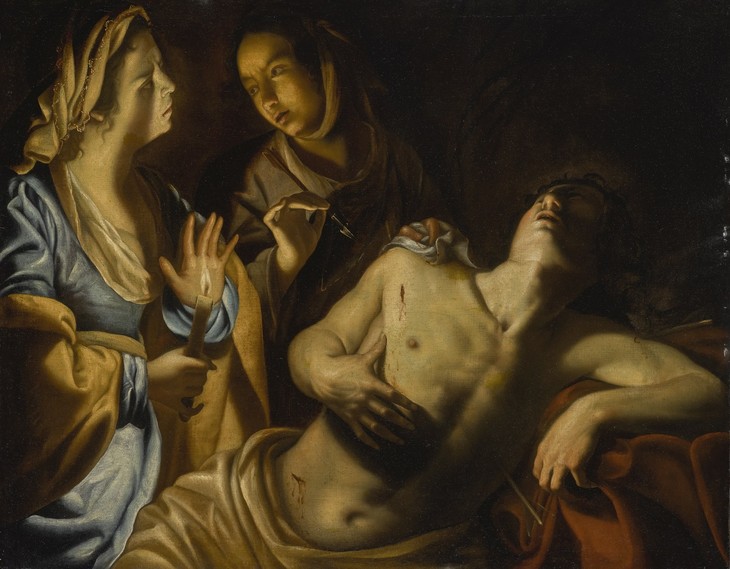 Artemisia Gentileschi, Saint Sebastian tended by Irene
Artemisia Gentileschi, Saint Sebastian tended by Irene
oil on canvas, 101 by 127.5 cm.
Artemisia Gentileschi was a talented and revolutionary painter who, more than 400 years ago, managed to make her way in a predominantly male environment. With her strong personality, strength, and perseverance, Artemisia enchanted Courts all around the globe, becoming one of the most sought after artists in Italy and Europe. After her death, like many of the talented women of her time, Artemisia fell into oblivion, only to be rediscovered in more recent times and thereafter become one of the most appraised artists in the world.
Thanks to her father Orazio Gentileschi Artemisia was introduced to the artistic tradition of Tuscany (that is, the stylistic strategy allowing to depict folds of cloth thanks to a structural use of chiaroscuro) and developed her skills in portraying close-to-life dresses. In her Saint Sebastian tended by Irene the choice of colours, played out between dark azure and the acid red gradation of varnish is particularly refined.
This painting, like many of her works, reflects her own personal suffering. Crude themes, deep anger and controversial characters pervade and characterize most of her paintings; but her works must not be considered a mere reflection of the violence she suffered as a young girl as this would undermine her natural talent. See Price Estimate
signed in monogram and dated lower left: 16 AB 07
formerly inscribed on a label affixed to a backing board: Tableau de cuivre/ de Brughel de Velours/ A été donné à mon père par/ Mme Marcel, veuve de l’orientaliste/ de ce nom qui avait fait partie/ de l’éxpedition d’Egypte et qui plus/ tard, devenu aveugle, dicta, et qui plus/ tard, à sa femme, une dictionnaire arabe/ for apprecié.
oil on copper, 23.8 by 18.4 cm.
Ambrosius Bosschaert the Elder was the first great Dutch specialist in fruit and flower painting and the head of a family of artists. He established a tradition that influenced an entire generation of fruit and flower painters in the Netherlands.
This exquisite still life presents various types of flowers that would not bloom in the same season. According to Sotheby's catalogue, the blooms depicted include two White Peonies, and then going clockwise from the lower left: Blue Aquilegia, Red Knautia, Tulip, Red and Blue Anemones, Wild Rose, Orange Aquilegia Chrysantha, Snake’s Head Fritillary (Fritillaria Meleagris Pallida), Forget-me-not, Yellow Begonia and Viola.
Rendering meticulous detail, Ambrosius Bosschaert the Elder conveyed the silky texture of the petals, the prickliness of the rose thorns, and the fragility of opening buds.
The painting included also symbolic and allegorical meanings: insects, short-lived like flowers, could be interpreted as a reminder of the brevity of life and the transience of its beauty, and the lizard (that is rare to find in a Bosschaert’s still life) as a symbol of evil. See Price Estimate
Selected Lots from the Old Master Drawings Sale, 30 January 2019, New York: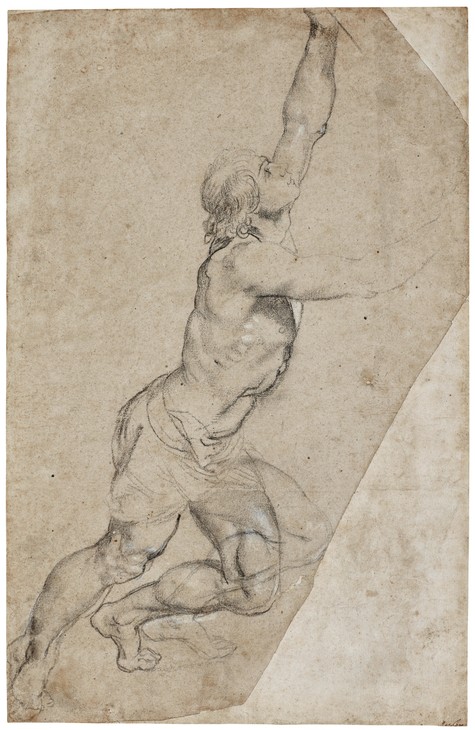
Sir Peter Paul Rubens, Nude study of a young man with raised arms
Black chalk, heightened with white; the two right corners cut; bears inscription in brown ink: Rubens. 491 by 315 mm.
When Rubens returned to Antwerp in 1608 after eight years in Italy, his talent was immediately acknowledged. In 1609 he was appointed court painter to Albert and Isabella, Archduke and Archduchess of Austria, and he received the first of a long series of commissions for altarpieces and other works. His first major undertaking after his return to the north, The Raising of the Cross, a large triptych painted in 1610-11 for the church of St. Walpurgis in Antwerp, established his reputation as the leading artist in the Low Countries and heir to the artists of Italy.
This is a study for one of the figures of the altarpiece straining under the weight of the cross. It shows how much Rubens had learnt in his Italian years from Michelangelo and from muscular antique sculptures. It also illustrates very clearly the artist’s thought processes and working method, as he developed the composition of the major altarpiece for which it is a study. Rubens followed the Italian practice of making preliminary compositional sketches and then working out the figures in detail by drawing them from life. Drawings like this provided models not only for Rubens, but also for his studio assistants who helped Rubens to complete his many commissions. See Price Estimate 
Giovanni Francesco Barbieri, called Il Guercino, Saint Peter receiving the keys from Christ
Pen and brown ink and wash over red chalk, within partial pen and brown ink framing lines;
bears old attribution in pen and brown ink, lower left: Guercino
380 by 287 mm.
In this exquisite work, Guercino lavishly used the pen loaded with ink, working with diluted ink washes to create a powerful sense of presence and a range of emotion. The washes are delicately brushed over the sheet, modelling the forms and suggesting a sense of fluidity. The paper seems infused with light. This atmospheric drawing relates to a devotional painting that was originally installed in the Cathedral of San Biagio, over the altar of the Guarini family chapel, and is now preserved in Cento’s Pinacoteca Civica.
Even at this early stage in his career, Guercino's virtuoso use of pen and wash was greatly admired, and he was a leading teacher in Cento. His robust, passionate style at this time was based on his study of the naturalism and expressive qualities of the Carracci in Bologna. However, his sojourn in Rome in 1621-23 had a major impact on his art. He became more measured and classical in his approach, aiming for a sense of grandeur and lucidity. Even though his style of painting changed, an intensity of purpose and a strong emotional charge, so evident in this enchanting study, still permeates his drawings. See Price Estimate
Selected Lots from the Master Paintings & Sculpture Day Sale, 31 January 2019, New York: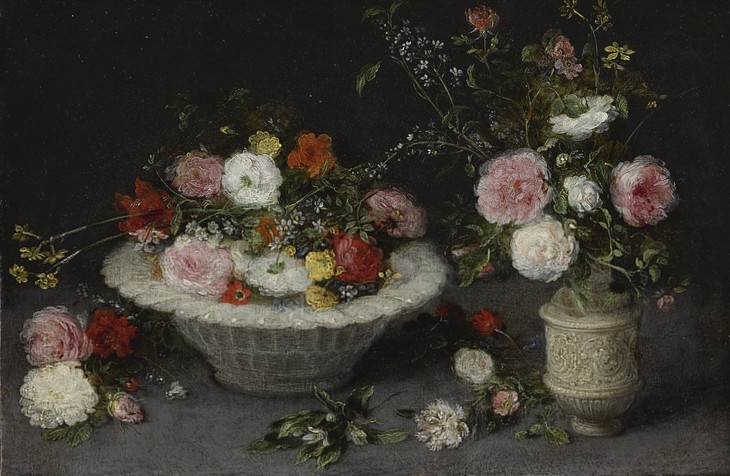 Jan Brueghel the Elder, Still life of roses and other flowers in a bowl and a vase, on a ledge
Jan Brueghel the Elder, Still life of roses and other flowers in a bowl and a vase, on a ledge
oil on copper, 13 by 19.7 cm.
Artists had painted flowers before Jan Brueghel the Elder, but none so comprehensively and exquisitely. His flower pieces encompass a variety of types, from bouquets of flowers arranged in jugs and glass vases to flower-filled wicker baskets and abundant flower garlands.
Brueghel’s paintings are carefully constructed, often containing many different types of flowers, but such bouquets were difficult to paint. In a letter to Borromeo’s agent, Ercole Bianchi, the artist confessed that making these types of painting was tricky because the flowers were only in bloom for four months, from April to August.
This painting shows Brueghel’s accuracy, illusionism and meticulous attention to every detail. He developed the genre of the flower piece at a time when new flowers from Southern Europe and Asia were being imported into the Netherlandish as bulbs, sometimes at extortionate prices. This sparked a fashion among the elite for ornamental gardens containing a variety of exotic flower species. See Price Estimate
Circle of Giovanni Stanchi, The four seasons: four anthropomorphic figures
a set of four, all oil on canvas
each: 96.8 by 72.5 cm.
This set of paintings is related to the compositions of Giovanni Stanchi, one of the finest exponents of 17th-century Roman flower painting.
Each shows a profile portrait made up of fruit, vegetables and plants relating to the relevant season.
The compositional format of the present series of anthropomorphic seasons reflects earlier iconographic and compositional models derived from the celebrated proto-surrealist paintings of heads created by the Mannerist artist Giuseppe Arcimboldo (1526–1593), who worked in the Habsburg court. This Milanese painter was the inventor and greatest exponent of the anthropomorphic figures made entirely of objects such as fruits, vegetables, flowers, fish, and books.figures.
During the course of 17th century the reference to the international Mannerism carried out in a triumphant Baroque style was highly usual, and the present four paintings are of great interest especially because of their pictorial quality. See Price Estimate
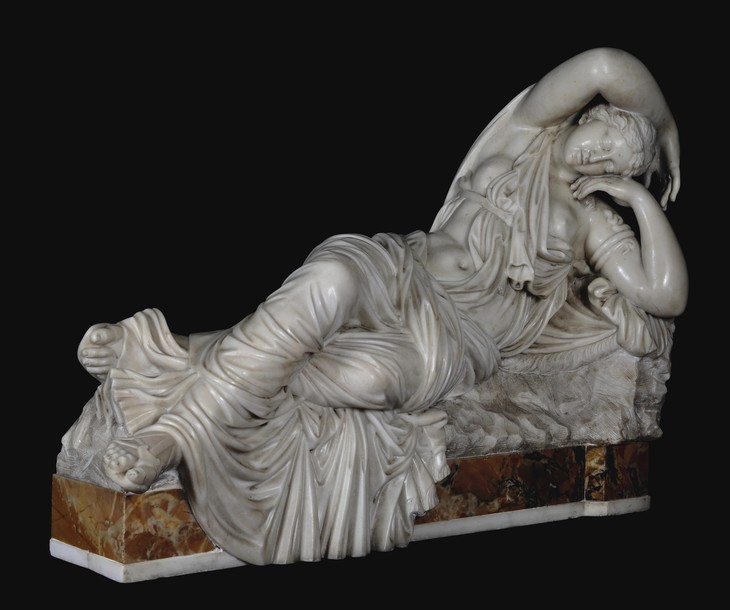 Italian, Rome, 18th/19th century, Sleeping Ariadne
Italian, Rome, 18th/19th century, Sleeping Ariadne
marble with variegated marble base
length 81 cm.
This is a copy after the famous sculpture Sleeping Ariadne held in the Vatican Museum, dating from the 3rd-century (itself a copy of an Hellenistic original). It is also well known for the other roman copy held at the Uffizi Gallery in Florence, that was originally owned by Cardinal Ippolito d’Este, and later purchased (1572) by the cardinal Ferdinando de’ Medici, who had the statue placed in Villa Medici in Rome over the Pincio Hill. Here there was a highly prestigious collection of antique marble. Many artists were deeply influenced by this outstanding sculpture, for instance, Diego Velazquez in his View of the garden of Villa Medici, and Artemisia Gentileschi both in her Cleopatra and Danae. See Price Estimate
This article was brought to you by the art historian Giulia Santoro in collaboration with Lot-Art.com
Lot-Art offers direct links to the most reputable auction houses and bidding platforms worldwide, to easily browse through all auctions from a single portal.
Lot-Art Investment Advisory can leverage on its extensive database, expertise, and international network to assist new and established collectors in acquiring quality artworks which are also sound financial investments.
The LOT-ARTeam
LOT-ART | Worldwide Auctioning Made Easy
Other interesting articles

|
Wed Apr 17 2024
Post-War & Contemporary Art at Venduehuis der NotarissenVenduehuis der Notarissen presents the April Auctions: Post-War & Contemporary Art on 8 – 23 April (Online Auction) The Lucassen Collection Part 1 on 24 April (Hammer Auction) The Lucassen Collection Part 2 on 8 – 25 April (Online Auction) Discover the Auction Highlights or browse the full catalogues here » SELECTED LOTS LEFT: Marlene Dumas (1953) - "Fear of Babies" The... |

|
Tue Apr 16 2024
The Cultural Wealth of Liechtenstein PalaceBernardo Bellotto (1722–1780), The Liechtenstein Garden Palace in Vienna from the Belvedere, 1759/60 | Photo Credits: LIECHTENSTEIN. The Princely Collections The Liechtenstein Palace, located in the heart of Vienna, is one of the most sublime expressions of Austrian Baroque architecture, constructed by the architect Domenico Martinelli. Invited by the noble Von... |

|
Mon Apr 15 2024
'The Berlin Sale' at Lempertz, GermanyLempertz, Germany presents 'Auction 1242 - The Berlin Sale' on April 20th. The catalogue features art related to Prussia, design, paintings, sculptures, porcelain and silverware. Discover the Auction Highlights or browse the full catalogue here » SELECTED LOTS LEFT: Wilhelm Brücke - "Parade by the Crown Prince's Palace at Unter den Linden" Oil on canvas. Gilded wooden... |
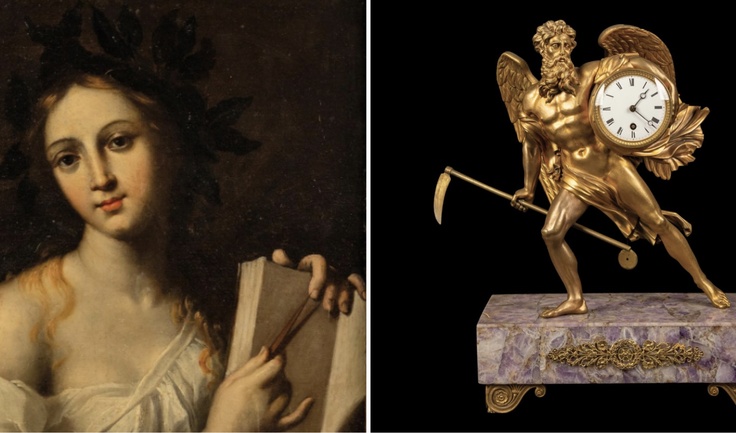
|
Sat Apr 13 2024
Fine & Decorative Art at Bolli & Romiti, RomeBolli & Romiti, Rome presents the auction "He Who Doesn't Seek is Found" on April 18th. The sale features a compendium of fine art, classic furniture and decorative art from a noble Roman family. Discover the Auction Highlights or browse the full catalogue here » SELECTED LOTS Venetian painter, early 19th century - "Views of Venice" Pair of oils on canvas. See Price... |